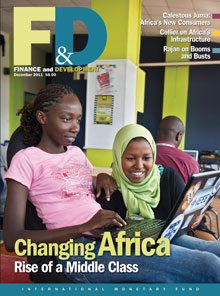Enduring poverty and conflict are so stark in Africa that it is sometimes difficult to see what else is happening.
In April 2011, a study published by the Columbia Journalism Review titled “Hiding the Real Africa” documented how easily Africa makes news headlines in the West when a major famine, pandemic, or violent crisis breaks. But less attention is given to positive trends and underlying successes.
In many cases, despite accelerated economic growth over the past 10 years, the rise of a middle class of consumers, and a more dynamic private sector attracting indigenous entrepreneurs, the narrative about Africa has remained focused on the bad news.
 That has, fortunately, started to change. This week’s cover story in The Economist, on “Rising Africa”, is testament to that. So too is the just-released December 2011 issue of Finance and Development (F&D) magazine on “Changing Africa: Rise of a Middle Class”.
That has, fortunately, started to change. This week’s cover story in The Economist, on “Rising Africa”, is testament to that. So too is the just-released December 2011 issue of Finance and Development (F&D) magazine on “Changing Africa: Rise of a Middle Class”.
Changing the narrative on Africa
The World Bank earlier published a book on African success stories, titled Yes Africa Can. And the Tunis-based African Development Bank marked 50 years after independence from colonialism for many African nations with a study called Africa in 50 Years’ Time: The Road Towards Inclusive Growth.
The study says that “Over the past decade, despite the successive global food and financial crises, Africa has been growing at an unprecedented rate. Though it will take decades of growth to make major inroads into Africa’s poverty, there is now a growing optimism about Africa’s potential.”
Exploring potential
This issue of F&D explores that potential, epitomized by our cover showing Kenyans Susan Oguya and Jamila Abass, co-founders of AkiraChix, who developed a mobile phone application for farmers in rural areas. They are working in a technology hub for IT investors and tech companies.
F&D’s lead article by Harvard professor Calestous Juma says a growing middle class is shifting perceptions about Africa’s prospects. The middle class may have comparatively little to spend by Western or Asian standards, but the traditional focus on eradicating poverty in Africa “distracted both African authorities and international donors from serious consideration of ways to promote prosperity infrastructure development: technical education, entrepreneurship, and trade,” he says.
Undeniably, much remains to be done. But cementing the economic growth in Africa is the key to helping the poorest members of society, as IMF African Department head Antoinette Sayeh points out. Also in this issue, Abebe Selassie writes about the challenges South Africa is facing and Oxford University economist Paul Collier discusses a crucial component of Africa’s needed infrastructure: railways.
For F&D’s “People in Economics” column, I profiled Nigeria’s economic czar, Ngozi Okonjo-Iweala, who is shaking things up in Africa’s most populous country. She says Africa has to make up for lost time in the global race to be competitive.
The regular “Picture This” section of F&D takes a look into the future, with a snapshot of what the African continent will look like fifty years from now.
Other articles in this issue of F&D look at:
- How clues to whether easy credit causes booms and busts in asset prices can be found in U.S. farmland prices a century ago;
- How commodity-exporting governments can reduce debt and still protect their least well off citizens;
- How, contrary to popular wisdom, commodity prices can be more stable than prices of manufactured products;
- How emerging economies are less dependent on debt, less vulnerable to volatile investment sentiment, and are rethinking the role of capital flows;
- How the euro area's long-term survival calls for a fundamental transformation of policymaking; and
- the author of Zombie Economics, John Quiggin, looks at the pros and cons of privatization.
*************
Finance & Development is a quarterly magazine of the IMF, publishing analysis of issues related to the international financial system, monetary policy, economic development, poverty reduction, and other world economic issues. The print and web editions are published quarterly in English, Arabic, Chinese, French, Russian, and Spanish.
For previous issues of F&D visit: http://0-www-imf-org.library.svsu.edu/external/pubs/ft/fandd/fda.htm
Visit F&D’s Facebook page: www.facebook.com/FinanceandDevelopment






